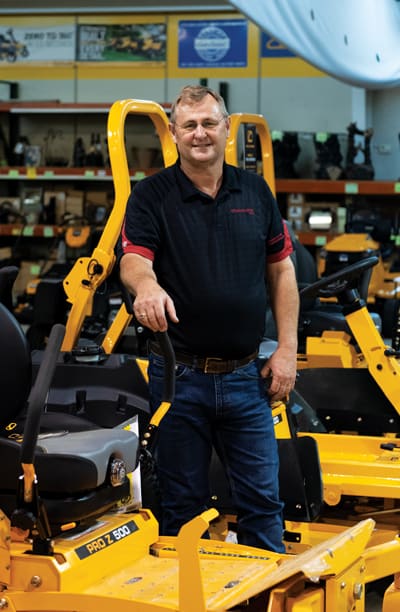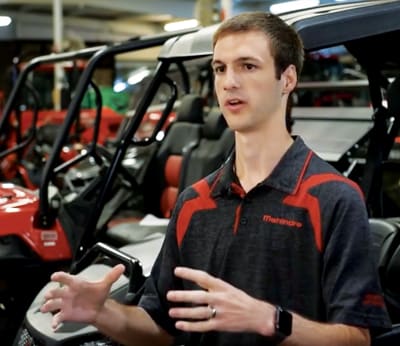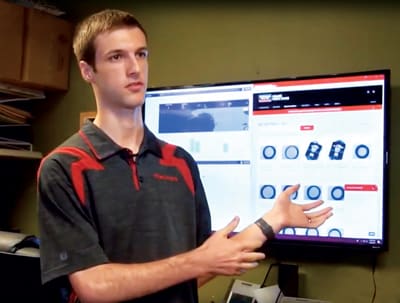TV advertising helped Bart Sherwood grow his dealership in its early days, and it remains an important part of Sherwood Tractor’s marketing program. However, Sherwood knew that digital marketing was the next necessary step, an area that was outside his comfort zone.
He turned to Patrick Richardson, a friend of his son Parker. Richardson took on the role of IT and digital marketing specialist from his base in Utah. He visits the dealership’s Rosebud and Blackwell, Ark., locations regularly along with providing monthly reports.
The dealership was named 2018 Dealership of the Year in the multi-store category.
Richardson talks with Rural Lifestyle Dealer about the components of the dealership’s digital marketing program and how they ensure a personalized customer experience. Richardson is also presenting at Rural Lifestyle Dealer’s Dealer Success Academy, set for March 7-8. Go here to learn more and register, www.RuralLifestyleDealer.com/Dealer-Success-Academy.
Rural Lifestyle Dealer: How do you get the most out of your digital marketing budget?
Richardson: Our budget for digital marketing is still in the first phase of figuring out what works because it’s not something that you can just throw a lot of money at. You have to build up your budget over time, otherwise you’ll end up spending a lot of unnecessary money.
Dealer Takeaways
- Technology should always have the goal of improving the customer experience.
- Adapt your online presence to make it better fit how customers search for information and use your website.
- Learn ways to create a customized experience with Google ads, such as through wild card keywords.
- Integrate new online functionality, such as chat boxes, to quickly provide what your customers need.
For instance, to get the best rate for pay-per-click ads, you have to establish the credibility of the ad. When you first start running pay-per-click ads, you’re paying a higher cost per click and it begins to go down as more people respond to the ad.
If you throw a huge budget at it at first, you’ll just pay a lot per click. But if you start out with a small budget and just grow that each month based on the results you’re seeing, you get much better results and your costs per click will go down in the process.
We’ve been able to learn month by month what’s working and what’s not by running different tests and looking at the results. We add budget to the ads that are efficient and pull back on the budget of the less efficient ones.
RLD: How do you analyze what’s working with your campaigns?
Richardson: I spend a lot of hours each month looking at the analytics of our website and our ad results because that’s how you identify what is and isn’t working. When you take the time to do this, you can find adjustments that will help improve the ad’s performance.
Sherwood Tractor
Owner: Bart Sherwood
Founded: 2009
Locations: 2 (Rose Bud and Blackwell, Ark.)
Mainline: Mahindra
Shortlines: Bad Boy, Bush-Whacker, Claas, Cub Cadet, STIHL, Vermeer and Precision Trailers
Employees: 14 (3 sales, 1 administration, 7 service, 3 parts)
Dealership Management System: Basic Software
Systems Website Vendor: Dealer Spike
Social channels: www.facebook.com/sherwoodtractor; www.instagram.com/sherwoodtractor; YouTube, https://bit.ly/2SFMsK7
For instance, we used to refer to “pre-owned tractors” on our website. I learned by studying the search result analytics that most people weren’t searching “pre-owned tractors.” Instead, they were searching “used tractors,” “second-hand tractors,” or “good priced tractors.” By calling everything “pre-owned” on our website, we were losing a huge segment of potential customers.
We went through our website and retitled things to the correct terminology. Now, the used section of our website is the second most popular page on our site, and we drive hundreds of visitors a month who are searching “used tractors for sale” on Google.
RLD: Can you provide some more specifics about your Google marketing campaigns?
Richardson: I have our Google Ads account divided into multiple campaigns based on the brand. I allocate the budget specifically based on the brands we carry and then within those brands, I break it down into different categories of tractors, side-by-sides and mowers, so that the ads are more specific and relevant.
One practice that has had a big impact on our search engine advertising has been inserting “wild card key words” in the ad text. Wild card key word insertion is a fairly new technique in search engine advertising. It allows advertisers to have the software dynamically modify the ad’s headline. This means we can create an ad that’s generic for all tractor models. When customers search a certain model, it will replace the header of the ad with the model they searched for, mimicking their search.

Bart Sherwood owns Sherwood Tractor, which has locations in Rosebud and Blackwell, Ark. Sherwood has found TV advertising to be good investment and brought in an expert, Patrick Richardson, to handle digital marketing for the dealership.
For instance, I might have an ad that says, “Mahindra Tractors, Sherwood Tractor.” Then, if they search “Mahindra 1533 prices,” our search ad would say, “Mahindra 1533 prices, Sherwood Tractor.” That way they’re clicking on exactly what they’re looking for, and I can make that ad go to the web page with that information. They’re coming into our site on the page for the 1533 model, not just on our home page.
RLD: Can you explain about your Facebook advertising campaigns?
Richardson: A good example of what works on Facebook is referred to as organic content in social media marketing. This is content that looks very personal and friendly. For example, I can post a picture that’s just a stock photo of a tractor and we can run it as an ad and get some interactions. Or, I can take a photo of tractors in our showroom and it will get about twice as much interaction rate because it’s an organic photo. It looks more personal and Facebook prioritizes organic content. Creating our own unique content gives Sherwood Tractor a huge advantage.
Something we do regularly is post photos on our social media channels. That’s been really helpful as well in growing our social media following. Then, we budget for Facebook and Instagram ads to boost those posts and reach people outside of just those who like our page. It’s been really helpful for growing store traffic.
RLD: How do you coordinate the timing of your campaigns?
Richardson: Our digital marketing campaigns are running continuously, and I adjust them monthly. At the end of every month, I review all the campaign data and our website performance and compile that into a PowerPoint report. This helps translate the data so it makes sense for other people in the company. It also helps me comb through everything and see what needs to be adjusted.

Patrick Richardson is Sherwood Tractor’s IT manager and digital marketing specialist. He is presenting at Rural Lifestyle Dealer’s Dealer Success Academy, set for March 7-8. Go here to learn more and register, www.RuralLifestyleDealer.com/Dealer-Success-Academy.
Also, I only adjust a Google ad’s budget on a monthly basis because every time you make a major change, those ads go through a 7-day learning phase. If you constantly change, you remain in that learning phase and don’t earn the credibility you need to reduce your pay-per-click costs.
RLD: How does your website support your marketing efforts?
Richardson: Our website vendor is Dealer Spike and one of the big advantages in working with them is they automatically funnel all the product catalog information directly into our website.
This saves us the time of having to constantly update the model information. I concentrate more on the front-end design to create a smooth experience for a website visitor. My specialty with web development is the user experience.
Every month, we feature different content on the home page. About 6% of our website visitors come back each month, so we want them to see different things as they continue to shop. We also have a system in place to make it easier for our employees to interact with our website customers. When someone fills out the contact form on our site, uses the website message box or sends us a message on Facebook, it’s entered into a system as a ticket with the customer’s information and message. I sift through those messages and assign them to the employee who can best respond. This keeps messages from getting lost in email inboxes and has become a very smooth way to communicate with customers.
We also recently added live chat functionality. We’ve found that it often only takes about 5 minutes to answer a customer’s question, so if we can encourage the live chat, we can answer their question quicker than through the form process.
RLD: Bart Sherwood, Sherwood Tractor’s owner, shared with us how he values and delivers great customer service. How do the marketing efforts deliver on that as well?
Richardson: With all of our online initiatives, we’ve really worked to make it a very personal experience. We want to understand our customers and their interests to ensure that our website content is relevant to them. The bottom line for our marketing efforts and for our website is to make it as easy as possible for people to shop.
RLD: What does it mean to be part of a dealership that’s growing so quickly and has been recognized as a Rural Lifestyle Dealer’s Dealership of the Year?
Richardson: It’s really exciting being a part of a dealership that has an attitude of growth and is constantly trying to improve our capacity to serve more customers. This kind of attitude forces everyone to think ahead about what they’re doing and how it will benefit the customer. That’s something I’m really passionate about on the technology side of things — trying to develop better solutions to serve customers. I work very hard to meet that mark of making technology customer-centered, efficient and the best solution to start with.
RLD: How do you see marketing evolving over the next 5 years?
Richardson: We see a large group of people who visit our website from their mobile phones, so we’ll continue to improve and find ways to reach people through the mobile and online experience. For instance, our customers can now schedule a service appointment on our website, and our online parts store, which we launched last summer, continues to grow. (Read more in the sidebar “Building an Online Parts Store”.)
I think the showroom shopping experience will continue to grow online with new technologies. It will become more possible to get that showroom experience from the comfort of a customer’s home, especially with the growth in mobile shopping.
Building an Online Parts Store

Sherwood Tractor’s new online parts store is an online initiative that serves its website visitors, while letting the parts staff better serve in-store customers. Patrick Richardson demonstrates its functionality.
Patrick Richardson, Sherwood Tractor’s IT manager and digital marketing specialist, spent about 5 months developing the dealership’s online parts store. Richardson’s expertise helped integrate the various platforms needed to set up the store, including Basic Software, their business management system, website (platform provided by Dealer Spike), Shopify e-Commerce platform as well as Stripe, PayPal and Apple Pay for credit card processing.
The store features about 500 of the most requested parts. If a part happens to be out of stock, an online customer can make a request for a special order, just like at the in-store counter. The online site features the dealership’s phone number prominently in case the customer has questions and they even have a loyalty program established. About 95% of the dealership’s sales have been to the eastern half of the U.S.
A workstation near the parts counter is the hub for fulfilling and shipping the orders and the integration with the dealer management system ensures inventory totals are correct for the parts counter staff.
View a video interview with Richardson about the online parts store, www.RuralLifestyleDealer.com/SherwoodOnlineParts.




Post a comment
Report Abusive Comment